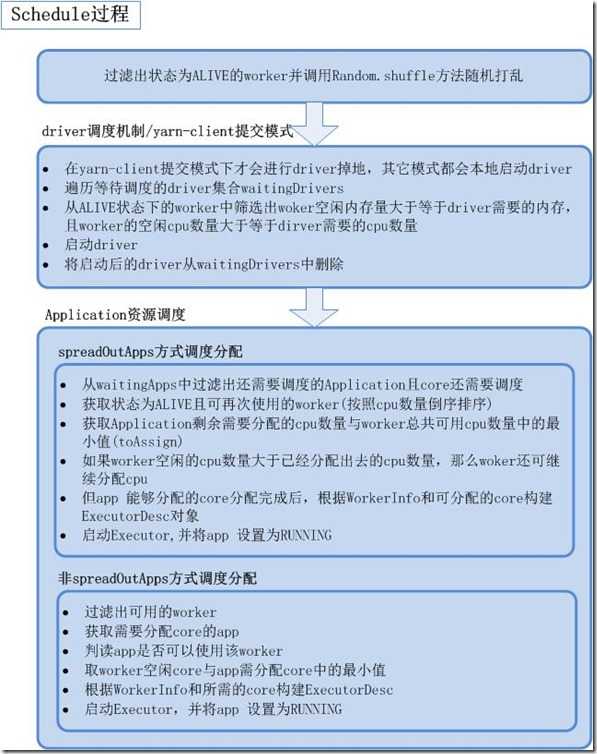Spark系列Master中的资源调度
Posted
tags:
篇首语:本文由小常识网(cha138.com)小编为大家整理,主要介绍了Spark系列Master中的资源调度相关的知识,希望对你有一定的参考价值。
资源调度
说明:
Application的调度算法有两种,分别为spreadOutApps和非spreadOutApps
spreadOutApps
- 在spark-submit脚本中,可以指定要多少个executor,executor需要多少个cpu及多少内存,基于该机制,最后executor的实际数量,以及每个executor的cpu可能与配置是不一样的。
- 因为spreadOutApps调度算法的总是基于总CPU总和来分配,比如要求3个executor每个要3个CPU,如果有9个worker每个有1个CPU,因为总共要分配9个core,所以每个worker分配一个core然后每个worker启动一个executor
- 最后启动9个executor每个executor1个cput core
非spreadOutApps
- 每个application都尽可能分配到尽量少的worker上,比如总共有10个worker,每个有10个core app总共要分配20个core,那么其实只会分配到两个worker上,每个worker都占满10个core.
Schdule方法源码分析
| 1 | /** |
| 2 | * Schedule the currently available resources among waiting apps. This method will be called |
| 3 | * every time a new app joins or resource availability changes. |
| 4 | */ |
| 5 | private def schedule() { |
| 6 | // 判断master状态,不为ALIVE时直接返回 |
| 7 | if (state != RecoveryState.ALIVE) { return } |
| 8 | |
| 9 | // First schedule drivers, they take strict precedence over applications |
| 10 | // Randomization helps balance drivers |
| 11 | // 获取状态为ALIVE的worker,并且随机打乱 |
| 12 | val shuffledAliveWorkers = Random.shuffle(workers.toSeq.filter(_.state == WorkerState.ALIVE)) |
| 13 | // 可用worker数量 |
| 14 | val numWorkersAlive = shuffledAliveWorkers.size |
| 15 | var curPos = 0 |
| 16 | |
| 17 | // diriver调度过程(yarn-client模式下) |
| 18 | for (driver <- waitingDrivers.toList) { // iterate over a copy of waitingDrivers |
| 19 | // We assign workers to each waiting driver in a round-robin fashion. For each driver, we |
| 20 | // start from the last worker that was assigned a driver, and continue onwards until we have |
| 21 | // explored all alive workers. |
| 22 | var launched = false |
| 23 | var numWorkersVisited = 0 |
| 24 | // 判读还有可用的worker且Driver还未启动 |
| 25 | while (numWorkersVisited < numWorkersAlive && !launched) { |
| 26 | val worker = shuffledAliveWorkers(curPos) |
| 27 | numWorkersVisited += 1 |
| 28 | // 判断当前worker空闲内存是否大于等于driver需要的内存,且Worker空闲的core数量大于等于dirver需要的core的数量 |
| 29 | if (worker.memoryFree >= driver.desc.mem && worker.coresFree >= driver.desc.cores) { |
| 30 | // 启动driver |
| 31 | launchDriver(worker, driver) |
| 32 | waitingDrivers -= driver |
| 33 | launched = true |
| 34 | } |
| 35 | curPos = (curPos + 1) % numWorkersAlive |
| 36 | } |
| 37 | } |
| 38 | |
| 39 | // Right now this is a very simple FIFO scheduler. We keep trying to fit in the first app |
| 40 | // in the queue, then the second app, etc. |
| 41 | // spreadOutApps调度方式 |
| 42 | if (spreadOutApps) { |
| 43 | // Try to spread out each app among all the nodes, until it has all its cores |
| 44 | // 遍历需要调度的app(Application),且该app中的core还需要调度 |
| 45 | for (app <- waitingApps if app.coresLeft > 0) { |
| 46 | val usableWorkers = workers.toArray.filter(_.state == WorkerState.ALIVE) |
| 47 | .filter(canUse(app, _)).sortBy(_.coresFree).reverse |
| 48 | // 可用worker的数量 |
| 49 | val numUsable = usableWorkers.length |
| 50 | // 存放app 需要分配core的结果 |
| 51 | val assigned = new Array[Int](numUsable) // Number of cores to give on each node |
| 52 | // 获取Application剩余需要分配的cpu数量与worker总共可用cpu数量中的最小值 |
| 53 | var toAssign = math.min(app.coresLeft, usableWorkers.map(_.coresFree).sum) |
| 54 | var pos = 0 |
| 55 | while (toAssign > 0) { |
| 56 | // 如果worker空闲的cpu数量大于已经分配出去的cpu数量,那么woker还可继续分配cpu |
| 57 | if (usableWorkers(pos).coresFree - assigned(pos) > 0) { |
| 58 | // 还需分配core的总数量减1 |
| 59 | toAssign -= 1 |
| 60 | // 在已分配app core结果集中加1 |
| 61 | assigned(pos) += 1 |
| 62 | } |
| 63 | pos = (pos + 1) % numUsable |
| 64 | } |
| 65 | // Now that we‘ve decided how many cores to give on each node, let‘s actually give them |
| 66 | for (pos <- 0 until numUsable) { |
| 67 | if (assigned(pos) > 0) { |
| 68 | // 根据WorkerInfo和所需的core构建ExecutorDesc |
| 69 | val exec = app.addExecutor(usableWorkers(pos), assigned(pos)) |
| 70 | // 启动Executor |
| 71 | launchExecutor(usableWorkers(pos), exec) |
| 72 | app.state = ApplicationState.RUNNING |
| 73 | } |
| 74 | } |
| 75 | } |
| 76 | } |
| 77 | // 非spreadOutApps调度方式 |
| 78 | else { |
| 79 | // Pack each app into as few nodes as possible until |
以上是关于Spark系列Master中的资源调度的主要内容,如果未能解决你的问题,请参考以下文章
